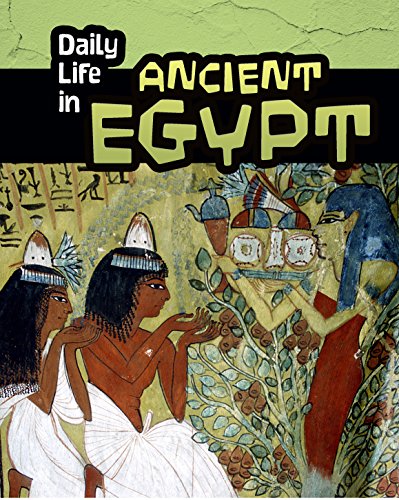-
If I Were A kid in Ancient Egypt
Cricket Media
eBook (Cricket Media, June 26, 2012)If YOU were a kid in the ancient world, everything would be different—or WOULD it? Kids today share many of the same experiences as kids who lived in the ancient world - even though thousands of years have gone by. If YOU were a kid living in ancient Egypt . . . Would you go to school or gym class? What would you eat for breakfast and dinner? What toys would you play with? What "house rules" would your parents expect you to obey? Where would you hang out with friends? If I Were a Kid in Ancient Egypt offers a fascinating look at the daily life of children growing up many years ago—and how it compares to life today.
-
Life in Ancient Egypt
Paul C Challen Challen
Library Binding (Crabtree Publishing Company, Oct. 1, 2004)The Egyptian civilisation is one of the oldest in human history. This book shows how the Ancient Egyptians built magnificent pyramids, developed a system of writing, harnessed the Nile River for agriculture, and made their own medicine. It is intended for ages 8-14. U
U
-
Daily Life in Ancient Egypt
Don Nardo
Library Binding (Heinemann, Jan. 1, 2015)What was life really like for everyday people in Ancient Egypt? In this detailed exploration of daily life in one of history’s greatest civilizations, readers will use primary sources and information from archeological discoveries to discover fascinating insights and debunk popular myths. Immersive timelines, maps and references to important people and events will bring children on a time-traveling journey through Ancient Egypt. V
V
-
Everyday Life in Ancient Egypt
Nathaniel Harris
Paperback (The Watts Publishing Group, April 10, 2003)A guide to life in ancient Egypt, with specially commissioned photographs which include surviving artefacts discovered in the tombs of the pharoahs, describing what they were used for and how they have survived. Suitable for National Curriculum History Key Stage 2.
-
Life in Ancient Egypt
Don Nardo
Hardcover (Referencepoint Pr Inc, Aug. 1, 2014)Offers narratives and first-hand accounts that shed light on the conditions and daily life in ancient Egypt. V
V
-
Living in Ancient Egypt
Norman Bancroft Hunt
Library Binding (Chelsea House Pub, Nov. 1, 2008)Explores the different "ideal" periods throughout history by examining all the aspects of daily life across all strata of society and focusing on the cycles of farming and trade, marriage and family life, education, and entertainment found in the ancient worlds. F
F
-
A Kid's Guide to Ancient Egypt
Jack L Roberts, Michael Owens
Paperback (CreateSpace Independent Publishing Platform, May 10, 2017)From pyramids to pharaohs, ancient Egypt has fascinated kids (and adults alike) for generations. In this engaging, easy-to-read book, kids are introduced to an awesome civilization that existed more than 5,000 years ago. Colorful photographs, informational charts and maps, and fun Did You Know facts all bring ancient Egypt to life for the young reader. The book covers topics such as Egyptian mummies, amazing Egyptian inventions (including hieroglyphic writing), the role of women in ancient Egypt, a look at daily ancient Egyptian life, and much more. A Kid’s Guide to Ancient Egypt is part of a series of books about countries and cultures around the world, available both in digital and print editions. Designed primarily for recreational, high-interest reading, the informational text series is also a great resource for students to use to research geography topics or writing assignments or as a supplement to a home-schooling social studies curriculum. The countries featured in this series – in addition to ancient Egypt -- currently include Australia, Costa Rica, France, Kenya, Thailand, and China. V
V
-
Everyday Life in Ancient Egypt
Kirsten C Holm
Paperback (PowerKids Press, Jan. 15, 2012)Most kids probably know a little about the pyramids of Egypt, but they may not know about the advanced people who designed and built them. This volume offers a behind the scenes look at what life was really like for the designers of the pyramids, the workers who built them, and the families at home who were running the households, attending schools, and worshipping in their religion. This volume takes readers beyond the text with fun facts and important research points. S
S
-
Home Life in Ancient Egypt
Leslie C Kaplan
Paperback (Rosen Publishing Group, Jan. 1, 2004)Describes family life in ancient Egypt, including marriage, children, the role of women, education, meals, personal hygiene, and religion. Q
Q
-
Everyday Life in Ancient Egypt
Jon Ewbank Manchip White
Hardcover (Hippocrene Books, May 1, 1990)Remarkably accurate picture of Egyptian life from the end of the third millenium BC to the Greek occupation in 330 BC examines the roles and tasks assigned to each section of the community and describes how people spent their leisure hours, how they dressed, what they ate and drank, and more. "A handy reference tool." Horn Book. 120 illustrations.
-
The Egyptians: Life in Ancient Egypt
Liz Sonneborn
Paperback (Lerner Books, Aug. 16, 2010)The Ancient Egyptians were known for their large stone pyramids, but did you also know that the Egyptians turned some cats into mummies after they died? They also made a strong kind of paper by pressing together layers of a plant, and they performed surgery as early as 4,500 years ago. Find out what life was like in the mighty empire of Ancient Egypt. In this book, you'll learn about people's daily activities, religion, buildings, inventions, and leaders. Photographs and vivid comic-style illustrations help bring this culture to life! V
V
-
The Egyptians: Life in Ancient Egypt
Liz Sonneborn, Samuel Hiti
Library Binding (Millbrook Pr, Aug. 1, 2009)Presents an introduction to ancient Egypt, discussing its government, religion, social classes, agriculture, writing, and pyramids. V
V